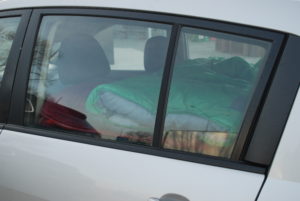
Brilliant light shines across the land and ideas can also be shared. Traveling has shown that many caring people share time and energy to build a healthy and strong nation. We do have needs for shelter and food as many are left with insecurity. Dedicated groups and volunteers are working hard to help. Awareness of need may also be necessary before those in positions of power shift policies to be more supportive of those who are living without houses or apartments or with too little food.
For those who are houseless but who do have a car a simple solution for slightly more comfortable sleeping is a platform in the backseat.

Three plastic tote boxes, slightly taller than regular size totes, but with one narrower than the regular size, fit neatly across my backseat. Topping the storage bins with an 1/2 inch thick exercise mat and a camping mat made a slightly more comfortable cushion but I also needed to add a pillow on top of the narrow tote as it was slightly shorter than the two full size totes. A comforter on top of the exercise mats added a little more comfort and a warm, cold weather rated, sleeping bag allowed me to stay warm at night without needing the car to be running.


The sleep platform is not as comfortable as a bed but it is more comfortable than trying to lay on the backseat or sit in the front seat with the seat leaning as far back as it can go. The platform makes the top of the backseat a pillow and is level enough with the top of the front seats to stretch legs out and over them. It is not a solution for someone who is tall or large however as some flexibility is needed and the area is still compact. I’m about 5 feet 6 inches tall as a reference.
For someone living houseless – working and living out of their car it might be a solution to consider trying as the tote bins and exercise and camping mats were fairly inexpensive, less than ten dollars for the totes and around $15 for each of the roll up foam mats. The cold weather sleeping bag was around $30 and I wore a hat for additional warmth as the temperature did drop below freezing.
Areas where rapid employment occurred had problems with inadequate housing being available for all of the new employees and other areas are simply very expensive even with a reasonable paying job. Others may have lost employment that covered the expense of housing but still own a car. Innovation sometimes means looking at things in a new way. When I was young my family traveled with a larger vehicle that had a platform in the back and being shorter as a child I could stretch out on it and sleep during long car trips – seat belt laws at the time of my earlier youth didn’t require riders in the back of the vehicle to wear a seat-belt, only front seat riders. The platform I built out of tote bins can be used for storage and sleep when the car is stopped. It would not be legal at this time to ride without a seat-belt.
The area created by the platform would be unlikely to be large enough for two people but for a solo driver it could also be handy in case of emergency stops or for a brief nap on long journeys when a hotel is the planned destination. Drowsiness can be a danger especially with the busy and fast pace of the traffic that occurs in many areas. Adequate sleep is also important to support health and the immune system.
A few tips for staying awake and early warning signs for when it is time to pull over:
- Warning sign: Eyes starting to squint and droop more often and they may possibly be dry and itchy from the forced air of the car heater.
- Tip: Being overly warm can increase sleepiness, an additional tip to the previous list would be open the window for a blast of cold air if you’re in a cold area or turn up the air conditioner if you’re in a warm area.
- Tip: Pull over and take a brief nap, 15-20 minutes can help. https://www.webmd.com/balance/features/the-secret-and-surprising-power-of-naps#1
- Tip: Or pull over and switch drivers if that is possible.
- Tip: Get a snack that isn’t too sugary or overly rick with fat calories which can make too much work for the digestive system. Caffeine from coffee or other caffeinated beverages can help but are not enough to combat a real need for sleep. https://www.livescience.com/55101-caffeine-does-not-help-sleep-deprived-people.html Choosing a sugary snack may give an initial boost of energy but can wear off and leave you more sleepy. A protein rich snack such as a protein bar or trail mix with nuts or seeds may help with alertness for a longer time. https://www.webmd.com/sleep-disorders/features/myths-facts#1
- Tip: Get some exercise, pull over for a brief walk. Warning sign: If the exercise worked for a while but then you notice yourself losing some physical coordination or are stiff and sore. You may notice yourself letting the car drift to close to the shoulder of the road and are hearing the rumble strips along the side more often.
- Warning Sign: The snack worked for a while but then the eyes started to droop again and maybe blink shut a few times – pull over because a rollover accident would be horrifying for you and any other travelers in your car or on the roadway. I have fallen asleep at the wheel before and woke up to the sound of the rumble strips. I over corrected at the sound and ended up flipping the car instead of smoothly getting back in the lane – I walked away with only a few bruises but the car was basically totaled from necessary bodywork. I also learned that it is good to have luggage and loose items secured in zipped or covered bags as loose items will also whirl around in the rolling car – it felt like being in a blender maybe – not an experience to repeat.
- Tip: Know your own limits and have the strength and courage to speak up for yourself. I was driving in a convoy of sorts and the other driver wanted to press on. I tried the cold air method and the snack method and did recognize the droopy eyes and I should have just pulled over. This was in the days before cellphones existed but sorting out travel plans later would be better than falling asleep at the wheel. Several books including this one helped me to improve my ability to recognize and speak up for my own needs: Butler G., and Hope T., Managing Your Mind: The Mental Fitness Guide, (Oxford University Press, 1995, Oxford or New York) [2007 edition, Amazon] It is written in sections, encyclopedia style, so a reader can choose from the Table of Contents the particular topics that sound most helpful to their own situation.
Thermal blankets are available that are very compact if a full-size sleeping bag wasn’t desired. More detail on warmth and a link for an emergency kit is included a little later in this post.
I’ve been traveling the last couple of days and got a new Garmin GPS device for the trip. Seeing more of the country has been a goal for a while and seeing if there is interest in my research has also been a goal. Update, while I didn’t find any direct support of my research work I did find that interest in the topics I write about seems to exist – and I got a better idea of what people are interested in the larger world than I had been inhabiting. seeing the country is beautiful and a little nerve wracking but the technology of the new GPS device is better than an early model I had used in the past.
Overall the GPS device helped me drive across the country quicker than I expected the trip to take but I also put my habit of not sleeping much to work by driving part of the night in addition to the daytime hours. The roads are less busy and I am not used to the fast pace of crowded multi lane highways. My own miniature hotel was my back seat with the soft platform. It allows me to stretch my legs out to be able to be slightly more comfortably than the width of the car allows laying directly on the backseat. The platform might look silly but it’s fairly comfortable. Never fear hotels, your business is likely safe because it’s not that comfortable either. But pulling over when tired is important, sleepy drivers can be a danger to self and others. The strategy was particularly useful though when an ice storm caused a highway closure, there are far more semi trucks on the road than I would have guessed when you see them all lining up as they also arrive at the blocked section of highway and have to pull over somewhere along the side of the highway or Truck Stop parking area.
Truck Stops have some convenient features I discovered while waiting during the second stop. One section of highway was closed during the night due to the stormy weather and ice rink like road surface and another section was closed the next morning due to the number of accidents that required towing before that section of highway could be reopened. While waiting during the middle of the night stop I wrote out a few ideas for making luggage carrier/platform units that could be handy for a business or other frequent traveler in case they too were stuck somewhere or just needed to pull over for a short nap. The platform is more comfortable than sitting upright in the front seat but it isn’t really comfortable enough for a regular night’s sleep – so again don’t worry about your industry’s business hotels and motels – even if my luggage platform idea got produced it would be for the occasional use of a frequent traveler, similar in a way to the home on wheels that semi-trucks contain for their driver’s comfort and convenience.
With the sleeper platform I already have a hotel on wheels just like the semi truckers but with limited comfort and you have to keep the engine running for warmth in cold weather. Even with a blanket along temperatures can drop dangerously low if someone fell asleep for long, the cold weather sleeping bag allows you to stay warm in more extreme temperatures. Sleeping bags have temperature ratings on the label and I choose the warmest available – 0-30’F. It is a good idea to bring along a few emergency items in case you get stuck or stopped somewhere. Thermal metallic blankets are available that fold very small but retain heat well if needed in an emergency. rei.com/ultimate-survival-technologies-featherlite-survival-kit
It is also important to shovel snow away from your exhaust pipe if you are stuck in a large pile of snow. The car exhaust can back up and cause poisonous levels of carbon dioxide to build up in the car. That might send a passenger to sleep forever.
My GPS device has been very helpful for navigating the complex highway and city streets.
My car did suffer some damage while traveling but I was not harmed. I do need to get more car repair work done and am retracing my travels to check in with family for the holiday season and save on hotel costs while the car repair work is completed, I can’t sleep in the car if it is in a repair shop after all – at least that’s the plan, I’ll keep trusting my GPS device to guide the way.

Disclaimer: Opinions are my own and the information is provided for educational purposes within the guidelines of fair use. While I am a Registered Dietitian this information is not intended to provide individual health guidance. Please see a health professional for individual health care purposes.
